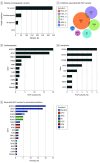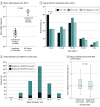Genetic Variants Associated With Unexplained Sudden Cardiac Death in Adult White and African American Individuals
- PMID: 34076677
- PMCID: PMC8173469
- DOI: 10.1001/jamacardio.2021.1573
Genetic Variants Associated With Unexplained Sudden Cardiac Death in Adult White and African American Individuals
Erratum in
-
Error in Affiliations.JAMA Cardiol. 2021 Sep 1;6(9):1098. doi: 10.1001/jamacardio.2021.2394. JAMA Cardiol. 2021. PMID: 34160560 Free PMC article. No abstract available.
Abstract
Importance: Unexplained sudden cardiac death (SCD) describes SCD with no cause identified. Genetic testing helps to diagnose inherited cardiac diseases in unexplained SCD; however, the associations between pathogenic or likely pathogenic (P/LP) variants of inherited cardiomyopathies (CMs) and arrhythmia syndromes and the risk of unexplained SCD in both White and African American adults living the United States has never been systematically examined.
Objective: To investigate cases of unexplained SCD to determine the frequency of P/LP genetic variants of inherited CMs and arrhythmia syndromes.
Design, setting, and participants: This genetic association study included 683 African American and White adults who died of unexplained SCD and were included in an autopsy registry. Overall, 413 individuals had DNA of acceptable quality for genetic sequencing. Data were collected from January 1995 to December 2015. A total of 30 CM genes and 38 arrhythmia genes were sequenced, and variants in these genes, curated as P/LP, were examined to study their frequency. Data analysis was performed from June 2018 to March 2021.
Main outcomes and measures: The frequency of P/LP variants for CM or arrhythmia in individuals with unexplained SCD.
Results: The median (interquartile range) age at death of the 413 included individuals was 41 (29-48) years, 259 (62.7%) were men, and 208 (50.4%) were African American adults. A total of 76 patients (18.4%) with unexplained SCD carried variants considered P/LP for CM and arrhythmia genes. In total, 52 patients (12.6%) had 49 P/LP variants for CM, 22 (5.3%) carried 23 P/LP variants for arrhythmia, and 2 (0.5%) had P/LP variants for both CM and arrhythmia. Overall, 41 P/LP variants for hypertrophic CM were found in 45 patients (10.9%), 9 P/LP variants for dilated CM were found in 11 patients (2.7%), and 10 P/LP variants for long QT syndrome were found in 11 patients (2.7%). No significant difference was found in clinical and heart characteristics between individuals with or without P/LP variants. African American and White patients were equally likely to harbor P/LP variants.
Conclusions and relevance: In this large genetic association study of community cases of unexplained SCD, nearly 20% of patients carried P/LP variants, suggesting that genetics may contribute to a significant number of cases of unexplained SCD. Our findings regarding both the association of unexplained SCD with CM genes and race-specific genetic variants suggest new avenues of study for this poorly understood entity.
Conflict of interest statement
Figures




References
-
- Benjamin EJ, Virani SS, Callaway CW, et al. ; American Heart Association Council on Epidemiology and Prevention Statistics Committee and Stroke Statistics Subcommittee . Heart disease and stroke statistics—2018 update: a report from the American Heart Association. Circulation. 2018;137(12):e67-e492. doi:10.1161/CIR.0000000000000558 - DOI - PubMed
-
- Elliott PM, Anastasakis A, Borger MA, et al. ; Authors/Task Force members . 2014 ESC Guidelines on diagnosis and management of hypertrophic cardiomyopathy: the Task Force for the Diagnosis and Management of Hypertrophic Cardiomyopathy of the European Society of Cardiology (ESC). Eur Heart J. 2014;35(39):2733-2779. doi:10.1093/eurheartj/ehu284 - DOI - PubMed
Publication types
MeSH terms
Grants and funding
LinkOut - more resources
Full Text Sources
Medical
Research Materials

